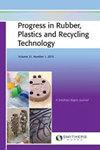通过傅里叶变换流变学研究热塑性弹性体材料及其硫化剂在拉伸/拉伸疲劳变形下的非线性力学行为
IF 1.6
4区 材料科学
Q4 MATERIALS SCIENCE, COMPOSITES
Progress in Rubber Plastics and Recycling Technology
Pub Date : 2024-08-07
DOI:10.1177/14777606241270513
引用次数: 0
摘要
傅立叶变换(FT)流变学为了解聚合物材料在长期持续动态载荷下的非线性机械行为开辟了新的领域。在大振幅动态机械应变和疲劳分析条件下,预测样品中裂纹出现的确切点已达到如此高的精度,这在以前的传统流变学和机械分析中是不可能实现的。在这项研究中,通过傅立叶变换研究,对热塑性弹性材料(TPE)和热塑性聚氨酯(TPU)与环氧氯丙烷-环氧乙烷-烯丙基缩水甘油醚(GECO)橡胶制成的热塑性硫化弹性体(TPV)在振荡应变控制拉伸试验下的疲劳行为进行了研究,以了解其线性和非线性机械行为。疲劳分析通过材料应力响应的指纹谐波,即二次谐波和三次谐波(I 2/1 和 I 3/1)进行,以确定应力非线性、不对称和大裂纹的形成。此外,这些高次谐波与 Neo-Hooke 和 Mooney-Rivlin 模型相拟合,从根本上了解了疲劳破坏的模式,并在理论拟合和实验结果之间建立了密切的一致性。利用应变-寿命曲线对试样的疲劳行为进行了深入研究,在应变振幅为 1.05 ∼ 1.05 时,观察到热塑性硫化弹性体的应变寿命比热塑性聚氨酯提高了 9 倍以上,这表明延展性在不断提高。最后,由于观察到 I 2/1 和 I 3/1 谐波与存储模量和复合模量相比对疲劳响应更为敏感,因此进一步强调了 FT 流变学的必要性。因此,傅立叶变换流变分析使当前的研究能够有效地确定每个试样的延展性,并预测所开发材料的动态使用寿命。本文章由计算机程序翻译,如有差异,请以英文原文为准。
Non-linear mechanical behaviour of thermoplastic elastomeric materials and its vulcanizate under tension/tension fatigue deformation by fourier transform rheological studies
Fourier transform (FT) rheology opens up novel frontiers in understanding non-linear mechanical behaviours of polymeric materials under sustained long-term dynamic load. The prediction of the exact point of appearance of a crack in a sample under dynamic mechanical strains of large amplitude and the fatigue analysis has been made possible to such degrees of precision, previously not possible through conventional rheological and mechanical analysis. In this work, the fatigue behaviour of a thermoplastic elastomeric material (TPE) and a thermoplastic vulcanizate (TPV) from thermoplastic polyurethane (TPU) and epichlorohydrin− ethylene oxide−allyl glycidyl ether (GECO) rubber is investigated by Fourier transform studies under oscillatory strain-controlled tensional test to understand the linear and non-linear mechanical behaviour. Fatigue analysis is performed through the fingerprint harmonics of the material’s stress response, i.e., the second and third harmonics, ( I 2/1 and I 3/1 ) to establish the stress nonlinearity, asymmetry, and the formation of macrocracks. Furthermore, these higher harmonics are fitted with the Neo-Hooke and Mooney-Rivlin model to fundamentally understand the mode of fatigue failure, and a close agreement between theoretical fitting and experimental outcomes is established. Strain-life curves were utilized for the thorough investigation of the fatigue behaviour of the specimens and more than 9-fold enhancement in the strain life of the TPV is observed over TPU at a strain amplitude of ∼1.05 indicating an increasing ductility. Finally, the necessity of FT rheology was further emphasised as it is observed that I 2/1 and I 3/1 harmonics are more sensitive towards fatigue response as compared to the storage modulus and the complex modulus. Henceforth, the FT rheology analysis has enabled the current study to efficiently establish the ductility of each individual specimens and for prediction of the dynamic service lifetime of the developed materials.
求助全文
通过发布文献求助,成功后即可免费获取论文全文。
去求助
来源期刊

Progress in Rubber Plastics and Recycling Technology
MATERIALS SCIENCE, COMPOSITES-POLYMER SCIENCE
CiteScore
4.40
自引率
7.70%
发文量
18
审稿时长
>12 weeks
期刊介绍:
The journal aims to bridge the gap between research and development and the practical and commercial applications of polymers in a wide range of uses. Current developments and likely future trends are reviewed across key areas of the polymer industry, together with existing and potential opportunities for the innovative use of plastic and rubber products.
 求助内容:
求助内容: 应助结果提醒方式:
应助结果提醒方式:


